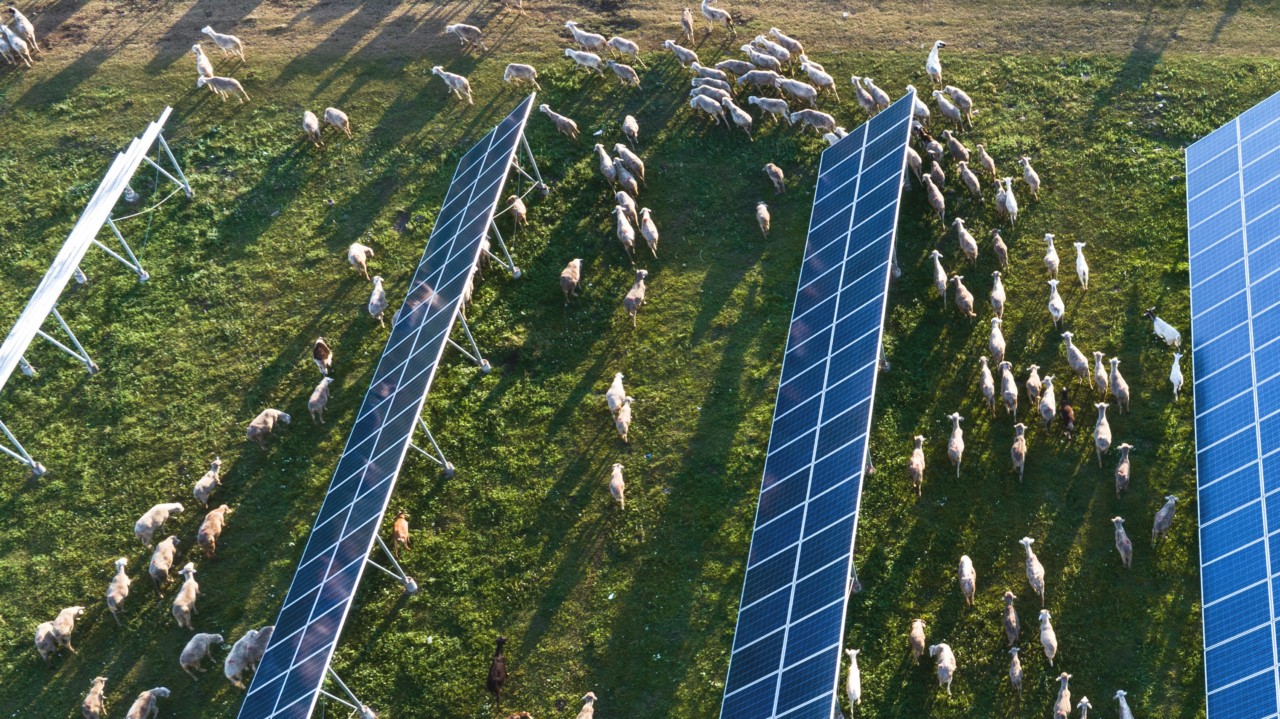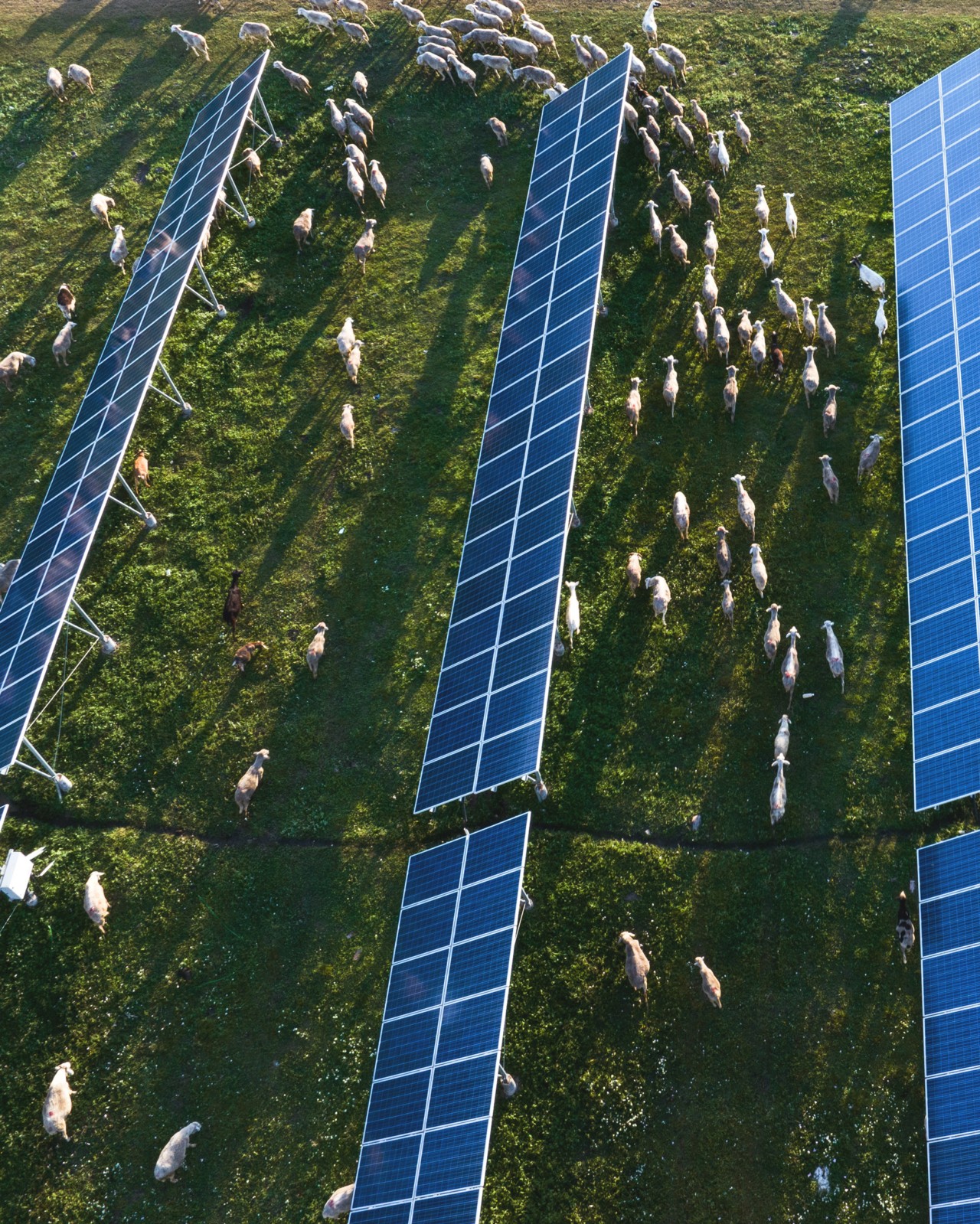

Photograph by Dowell / Getty Images
WORDS BY CHRIS BARANIUK
The solar farm where Jess Gray’s sheep were giving birth was only four miles away—but after a February ice storm this year, it took her more than an hour to get there in her pickup truck. Fallen trees and power lines littered the roads. Ice coated the ground and encrusted the wires of the chain link fence enclosing her flock. Gray was anxious to see if any had survived.
“I got to the farm and my sheep were lambing in the middle of it,” she recalled. “Lambs were running around and playing.”
Not one sheep died in the storm. Gray, CEO of Gray’s LAMBscaping, which places herds of sheep on solar farms around Virginia and beyond, credits her animals’ survival instincts—and also the solar panels. The roof-like structures appear to have sheltered the sheep during the worst of the weather.
Agrivoltaics, which mixes farming and solar energy installations, is on the rise. Some farmers and researchers say that solar panels are good for livestock and crops. Plus, solar companies benefit from relatively low-cost grazing and land maintenance to prevent vegetation overgrowth from shading the solar panels. Partnering with farmers also means these companies can argue that their solar installations support agriculture, rather than squeezing it out—a common criticism leveled at commercial-scale solar operations.
It sounds like one of the biggest win-wins of the energy transition. But agrivoltaic projects are not without their complexities.
Gray and her husband launched their sheep farming business four years ago with 30 animals on their small home farm. Now they have roughly 1,300 sheep—a mark of growth made possible by leveraging around 4,000 acres of solar energy sites for grazing. They can charge grazing fees to the solar companies, too. “It’s such a blessing,” Gray said.
More than 130,000 acres of solar farms across 500 sites in the United States were grazed by livestock in 2024, according to the American Solar Grazing Association. Sheep on solar farms do not typically interfere with solar infrastructure, and they’re small enough to easily get under most panel arrays. The panels offer shelter from storms and shade during heatwaves. There are, however, some “knowledge gaps” in the world of solar grazing, according to a 2025 study, which considers how the practice may affect local native biodiversity and parasite exposure.
Gray, who is a board member of the American Solar Grazing Association, explained that her sheep generally reside on a solar farm for one year at a time before being moved on to another location.
Gray farms sheep for their meat, but solar grazing even seems to improve the animals’ wool. “If we can create an environment with less stress, the effort going into the fleece is going to be better,” said Gray. A preprint study on agrivoltaics in Australia, not yet peer reviewed, mentions this effect; it has also been cited by energy companies promoting solar grazing.
“More than 130,000 acres of solar farms across 500 sites in the United States were grazed by livestock in 2024.”
“I can think of a few landowners I have met who have solar panels on their property, and that is their experience, that they’ve improved production under panels,” said Angus Dunne, lead author of the Australian preprint study. Dunne, formerly of the Australian National University, currently works in drought resilience.
While more research would help to shed light on how common this effect really is, Gray said it makes sense that a sheep’s environment affects the quality of its fleece. It’s well established that drought, for example, can cause sheep to grow less wool, and environmental debris such as dust, more prevalent in dry years, affects quality, too. Other research suggests that solar-shaded grasslands sometimes cope better with drought.
The only downside to solar grazing that Gray said she has found to date is that commercial solar farms often don’t have their own wells or water supplies, which means that she and her husband must regularly haul water to their herds at various locations.
While sheep are anecdotally the most common livestock used for solar grazing in the U.S., some farmers also graze cattle under panels. In such situations, the panels must be raised at least 7 feet off the ground so cows can walk beneath them.
Crops may also benefit from the shade and microclimate that solar panels provide. Reports suggest agrivoltaic systems can help farmers grow more rice and sugarcane, for example. Better shading sometimes gives broccoli a richer color. Photovoltaic arrays can also protect vines from heat waves, improving the flavor profile of grapes used in winemaking. In Sicily, solar panels are even helping to save a rare citrus fruit: the citron of Calabria.
While this all sounds very exciting, whacking solar panels over a bunch of crops doesn’t always result in improved productivity. The holy grail of agrivoltaics would be to take a specific location and decide what configuration of solar panels and crops would work best there, year-on-year, said Dr. Kate Doubleday, a research engineer at the National Renewable Energy Laboratory: “We’re definitely not there yet at all.”
A long list of factors can affect the growth of agrivoltaic crops. Do you have fixed panels, or tilting ones that track the sun? How much space is left between panels and between rows? How tall are the arrays? How much does the weather vary in this area? You get the picture.
“The photovoltaic panels cast this unusual shade pattern over the course of the day. It’s unlike a natural canopy trees might cast,” said Doubleday. “We’re still understanding how that might influence crop growth.”
In a paper published this July, Doubleday and colleagues described the findings of a three-year study tracking the performance of various crops under a non-moving, fixed-tilt agrivoltaic system in Massachusetts.
The research, funded by the Department of Energy and conducted from 2016 to 2018, found significant variability in crop growth, including peppers, kale, and broccoli. Solar-shielded crops in 2016—a hot, dry year—performed as well as crops in an area fully exposed to the sun. In wetter years, however, the agrivoltaic crops failed to produce as strong a yield. Doubleday notes that wetter years might have seen more cloud cover overall. The additional shading provided by solar panels was perhaps excessive, though the exact cause of reduced yields can be tricky to tease out.
“There’s potential for more consistent benefits across years, particularly in dry and arid climates where there can be water savings and increased water-use efficiency,” said Doubleday.
A similar multi-year study funded by the DOE is currently underway at Iowa State University. “We have some preliminary observations from the first year,” said horticulturist Dr. Ajay Nair. “Broccoli did not do that well in the agrivoltaic system—but the summer squash and peppers did.” While the agrivoltaic broccoli yield was half that of broccoli grown without solar panels overhead, the summer squash and pepper yield was 30% higher when grown under panels.
“I can think of a few landowners I have met who have solar panels on their property, and that is their experience, that they’ve improved production under panels.”
Nair, like Doubleday, stresses that data from multiple years is necessary to properly evaluate how the system performs. The Iowa State study, based at an experimental solar farm built by Alliant Energy, features a variety of agrivoltaic setups, with some crops grown under fixed panels and some under panels that track the sun. Control crops grow out in the open.
There are nitty-gritty things to think about when putting solar panels over plants, Nair emphasized. How does rain run off them, for instance? Is there a risk of it rushing off in a torrent and eroding precious, nutrient-rich topsoil? And what about farm vehicles or equipment—can they co-exist with the panels, too? Nair said he and his colleagues are using farming methods in their study comparable to those you’d find on a commercial farm.
One thing that solar farms do come with, though, is security. The fencing that surrounds long rows of panels keeps Jess Gray’s sheep in place while—along with guard dogs—protecting them from predators; in a crop agrivoltaic set-up, it would keep deer away, added Nair: “That fence is a big, big benefit to the grower.”
Besides the vagaries of the seasons, agrivoltaics as a practice still faces social and political challenges. Dunne pointed out that, in some parts of Australia, the rise of solar farms has created animosity, and even “jealousy,” between neighboring landowners. “You may get quite a lucrative deal to host the solar panels,” he said. “[Whereas,] I might host the transmission line, and I might get a very small return for that.”
Renewable energy in the U.S. has become increasingly politicized, said Dr. Stacie Peterson, executive director of the American Solar Grazing Association. “I worry that this could get a little entrenched.” Some people accuse solar farms of taking over land that could be used for growing food, but that is exactly the problem that agrivoltaics, in principle, can solve, she argued.
Peterson says she knows farmers whose businesses struggled until they boosted their income through grazing their livestock on solar sites. “This is a tremendous opportunity for rural communities,” she said. “They haven’t seen an opportunity like this since the railroads.”
‘It’s Such a Blessing’: The Farmers Embracing Solar Arrays